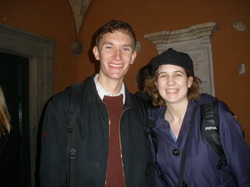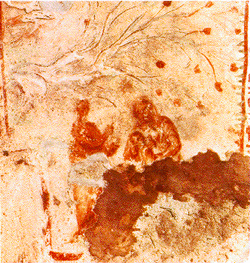On Tuesday we had our first major field trip with Dr. Lev, our fabulous Christian Art and Architecture professor. She is feisty, incredibly knowledgeable, and so funny! For many of us it was also our first experience with the public transportation system. The buses in Rome are VERY CROWDED and you really have to watch for pick pockets! Our destination was the Catacombs of Priscilla, one of the 60-some underground burial sites in Rome.
The idea behind the catacombs (a name that comes from the Greek words for "down" and "tomb") is that the over one million people in Rome could not all be buried in their own graves and early Christians did not want to cremate their dead because of their belief in the bodily resurrection. Thus Romans created these underground labyrinths, which consisted in mausoleums for wealthy families and shelf graves to place bodies on for poor families. The corridors were dark and damp - railings were wet because of the condensation and I was very glad I had my Merrills on because the floors were rough. It was a little spooky walking around in this maze and our tour guide had a little fun by turning the lights out on us at one point!
People were much smaller than they are now and the infant mortality rate was much higher, so many of the shelves were quite short! I don't think I would have fit! :-) Bodies were not placed in coffins but were rather just wrapped in linen with lime. All the graves were then closed with cement and the name of the deceased and date of death (very important - birthday into eternal life!) were written outside. Some were anonymous if people were illiterate.
Now here comes the cool part...the catacombs give us some of our earliest versions of Christian art. Because of the incarnation, God becoming man, Christians have used images to transmit the Gospel message to the world. Ancient Greeks and Romans were dependent on images to understand things. These pictures could contain incredible amounts of theological information.
There are definite patterns in the images we keep seeing. Jonah appears quite frequently...in fact we later saw that he has a place of prominence in the Sistine Chapel because of the typological relationship between Jonah and Christ. The ichthus, the ancient Christian fish symbol, is also common because of the way the Greek letters spell out "Jesus Christ, Son of God, Savior." This symbol was used as a secret sign of Christianity when the religion was illegal. I got very excited to see this symbol because of its prominence in the TEC (Teens Encounter Christ) program of which I am involved!
Other symbols include the anchor, symbolizing salvation and home; and the dove with an olive branch, symbolizing peace and new life. The peacock was an ancient pagan symbol of immortality that was later adopted by the Christians.
Perhaps my favorite part of the catacombs was seeing the earliest known image of the Madonna and Child. It was very small and I definitely would have missed it had the tour guide not pointed it out, but it was truly beautiful. With the mother and son is a star, showing that Christ is truly the fulfillment of Old Testament prophecies. Quite magnificent!
You'd think being in the catacombs would be kind of depressing and dreary, thinking of all these people who have died, but really it was a joyful visit, because of looking ahead to eternal life, a belief the early Christians truly clung to. We must truly live each day with our eyes set on eternity, recognizing that this world is not all that there is.
The idea behind the catacombs (a name that comes from the Greek words for "down" and "tomb") is that the over one million people in Rome could not all be buried in their own graves and early Christians did not want to cremate their dead because of their belief in the bodily resurrection. Thus Romans created these underground labyrinths, which consisted in mausoleums for wealthy families and shelf graves to place bodies on for poor families. The corridors were dark and damp - railings were wet because of the condensation and I was very glad I had my Merrills on because the floors were rough. It was a little spooky walking around in this maze and our tour guide had a little fun by turning the lights out on us at one point!
People were much smaller than they are now and the infant mortality rate was much higher, so many of the shelves were quite short! I don't think I would have fit! :-) Bodies were not placed in coffins but were rather just wrapped in linen with lime. All the graves were then closed with cement and the name of the deceased and date of death (very important - birthday into eternal life!) were written outside. Some were anonymous if people were illiterate.
Now here comes the cool part...the catacombs give us some of our earliest versions of Christian art. Because of the incarnation, God becoming man, Christians have used images to transmit the Gospel message to the world. Ancient Greeks and Romans were dependent on images to understand things. These pictures could contain incredible amounts of theological information.
There are definite patterns in the images we keep seeing. Jonah appears quite frequently...in fact we later saw that he has a place of prominence in the Sistine Chapel because of the typological relationship between Jonah and Christ. The ichthus, the ancient Christian fish symbol, is also common because of the way the Greek letters spell out "Jesus Christ, Son of God, Savior." This symbol was used as a secret sign of Christianity when the religion was illegal. I got very excited to see this symbol because of its prominence in the TEC (Teens Encounter Christ) program of which I am involved!
Other symbols include the anchor, symbolizing salvation and home; and the dove with an olive branch, symbolizing peace and new life. The peacock was an ancient pagan symbol of immortality that was later adopted by the Christians.
Perhaps my favorite part of the catacombs was seeing the earliest known image of the Madonna and Child. It was very small and I definitely would have missed it had the tour guide not pointed it out, but it was truly beautiful. With the mother and son is a star, showing that Christ is truly the fulfillment of Old Testament prophecies. Quite magnificent!
You'd think being in the catacombs would be kind of depressing and dreary, thinking of all these people who have died, but really it was a joyful visit, because of looking ahead to eternal life, a belief the early Christians truly clung to. We must truly live each day with our eyes set on eternity, recognizing that this world is not all that there is.

